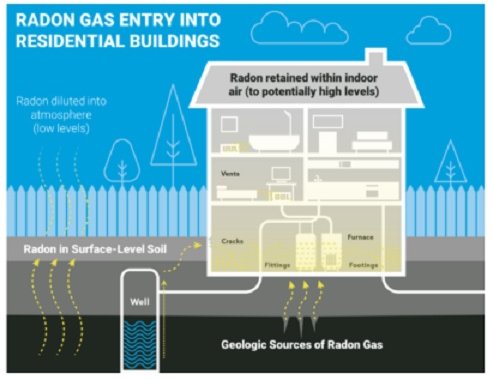
Imagine discovering that your home—your sanctuary—could be exposing you and your family to one of the leading causes of lung cancer.
This is the reality for thousands of Canadian homeowners each year due to radon, a silent yet dangerous intruder.
The good news? You can take simple, effective steps to address the problem and protect your loved ones.
What is Radon and Why Should You Care?
Radon is a radioactive gas that originates from the natural decay of uranium in soil and rocks.
It sneaks into homes through cracks in foundations, construction joints, sump pumps, and even around pipes. Because it’s invisible, odourless, and tasteless, you won’t know it’s there unless you test for it.
Here’s the real kicker: radon exposure is the number one cause of lung cancer in non-smokers and the second overall after smoking.
Each year, radon is linked to over 3,000 lung cancer deaths in Canada, which is more than the annual number of deaths from car accidents.
Where is Radon Most Common?

Radon can be found in homes across Canada, but some regions are hotspots.
Saskatchewan, Manitoba, New Brunswick, and Yukon have some of the highest radon levels, comparable to countries like Sweden and the Czech Republic. However, elevated radon levels can be found anywhere, including urban centres like Toronto, Vancouver, and Montreal.
About 1 in 10 homes in Canada exceeds Health Canada’s guideline of 200 Bq/m³, making testing a must for every household.
How to Know If Your Home Has a Radon Problem
The only way to know if your home has high radon levels is to test.
Testing is straightforward and affordable. You can pick up a do-it-yourself radon test kit for as little as $30–$50 or hire a certified professional for a more in-depth analysis.
Testing should be done over at least three months, ideally during the colder months when homes are sealed and radon levels are highest.
What If My Home Has High Radon Levels?
Let’s say your home tests above the 200 Bq/m³ guideline. Don’t panic—there are proven ways to fix it. The most effective method is active soil depressurisation (ASD), which involves installing a pipe-and-fan system to vent radon from beneath your home to the outside.
Here’s what you can expect:
- Cost: Installing an ASD system typically ranges from $2,000 to $3,000, depending on the size of your home and the complexity of the system.
- Effectiveness: These systems can reduce radon levels by up to 90%, giving you peace of mind.
- Savings: Addressing radon early can save on future healthcare costs and prevent lung cancer cases, which are far more costly to treat.
If your home’s radon levels are only slightly above the limit, sealing foundation cracks and improving ventilation can also make a significant difference, often for just a few hundred dollars.
The Cost of Inaction
Consider this: not addressing high radon levels in your home could be likened to living with a smoker.
Over time, the exposure adds up, and the risk of developing lung cancer increases significantly. Lung cancer linked to radon exposure is particularly aggressive and has low survival rates. Can you really afford not to act?
How Other Canadians Are Tackling Radon
Take Sarah from Calgary as an example. After testing her home and finding radon levels of 400 Bq/m³—double the recommended limit—she invested in an ASD system for $2,500. “It was the best money I’ve ever spent,” Sarah says. “I sleep better knowing my family is safe.”
Or consider Mike in Winnipeg, who sealed cracks in his basement and added a ventilation system for just $800. His radon levels dropped by 50%—enough to bring them below the guideline.
Why You Should Act Now
November is Radon Action Month in Canada, the perfect time to test your home and take steps to reduce radon exposure. Testing and mitigation aren’t just about health—they’re also about protecting your home’s value. A radon-safe home is more marketable and reassures potential buyers.
Get Started Today
Testing is easy:
- Purchase a test kit for as little as $30-$50 (available online or at hardware stores).
- Leave the detector in a frequently used room (like your basement or living room) for three months.
- Send it back to the lab for analysis.
If your home’s radon levels are high:
- Visit TakeActionOnRadon.ca or C-NRPP to find certified professionals who can help.
- Explore mitigation options like ASD or foundation sealing.
The Bottom Line
Radon is a serious but manageable risk.
By testing your home and taking action if needed, you can protect your family from the long-term effects of radon exposure.
It’s an investment in your health, your peace of mind, and your property.
Rylie C.
Sources




Comments